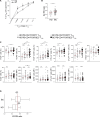CD4+FOXP3Exon2+ regulatory T cell frequency predicts breast cancer prognosis and survival
- PMID: 39813341
- PMCID: PMC11734725
- DOI: 10.1126/sciadv.adr7934
CD4+FOXP3Exon2+ regulatory T cell frequency predicts breast cancer prognosis and survival
Abstract
CD4+FOXP3+ regulatory T cells (Tregs) suppress immune responses to tumors, and their accumulation in the tumor microenvironment (TME) correlates with poor clinical outcome in several cancers, including breast cancer (BC). However, the properties of intratumoral Tregs remain largely unknown. Here, we found that a functionally distinct subpopulation of Tregs, expressing the FOXP3 Exon2 splicing variants, is prominent in patients with hormone receptor-positive BC with poor prognosis. Notably, a comprehensive examination of the TCGA validated FOXP3E2 as an independent prognostic marker in all other BC subtypes. We found that FOXP3E2 expression underlies BCs with defective mismatch repair and a stem-like signature and highlights pathways involved in tumor survival. Last, we found that the TME induces FOXP3E2 through the CXCL12/CXCR4 axis and confirmed the higher immunosuppressive capacity of FOXP3E2+ Tregs derived from patients with BC. Our study suggests that FOXP3E2+ Tregs might be used as an independent biomarker to predict BC prognosis and survival and to develop super-targeted immunotherapies.
Figures









References
-
- Togashi Y., Shitara K., Nishikawa H., Regulatory T cells in cancer immunosuppression—Implications for anticancer therapy. Nat. Rev. Clin. Oncol. 16, 356–371 (2019). - PubMed
-
- Dunn G. P., Bruce A. T., Ikeda H., Old L. J., Schreiber R. D., Cancer immunoediting: From immunosurveillance to tumor escape. Nat. Immunol. 3, 991–998 (2002). - PubMed
-
- O’Donnell J. S., Teng M. W. L., Smyth M. J., Cancer immunoediting and resistance to T cell-based immunotherapy. Nat. Rev. Clin. Oncol. 16, 151–167 (2019). - PubMed
-
- Blanco-Heredia J., Souza C. A., Trincado J. L., Gonzalez-Cao M., Goncalves-Ribeiro S., Gil S. R., Pravdyvets D., Cedeno S., Callari M., Marra A., Gazzo A. M., Weigelt B., Pareja F., Vougiouklakis T., Jungbluth A. A., Rosell R., Brander C., Tresserra F., Reis-Filho J. S., Tiezzi D. G., de la Iglesia N., Heyn H., De Mattos-Arruda L., Converging and evolving immuno-genomic routes toward immune escape in breast cancer. Nat. Commun. 15, 1302 (2024). - PMC - PubMed
MeSH terms
Substances
LinkOut - more resources
Full Text Sources
Medical
Research Materials

